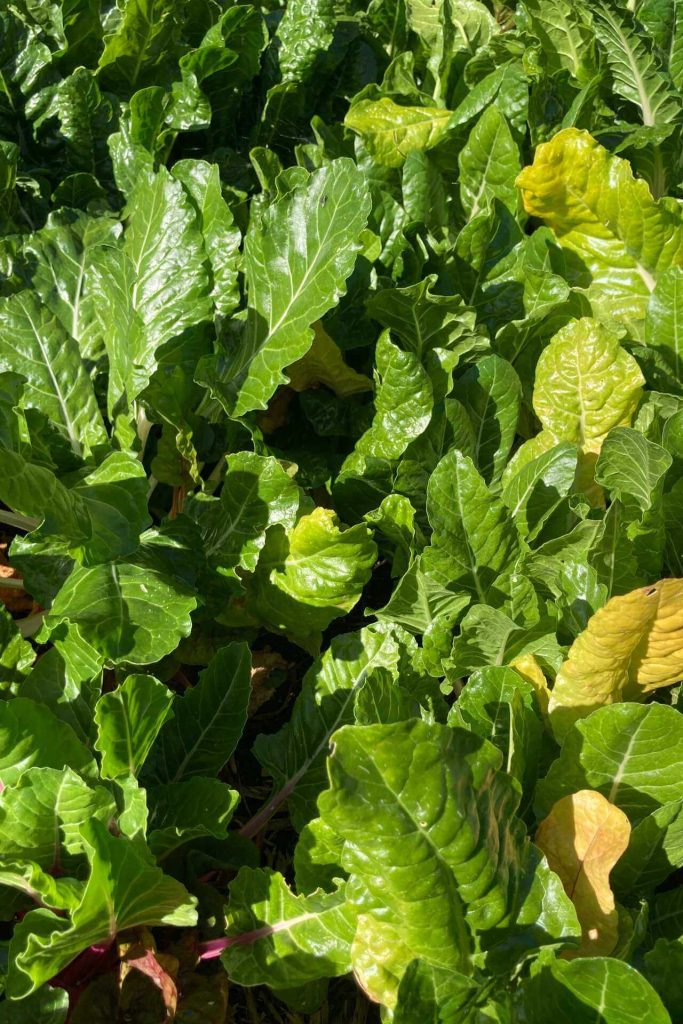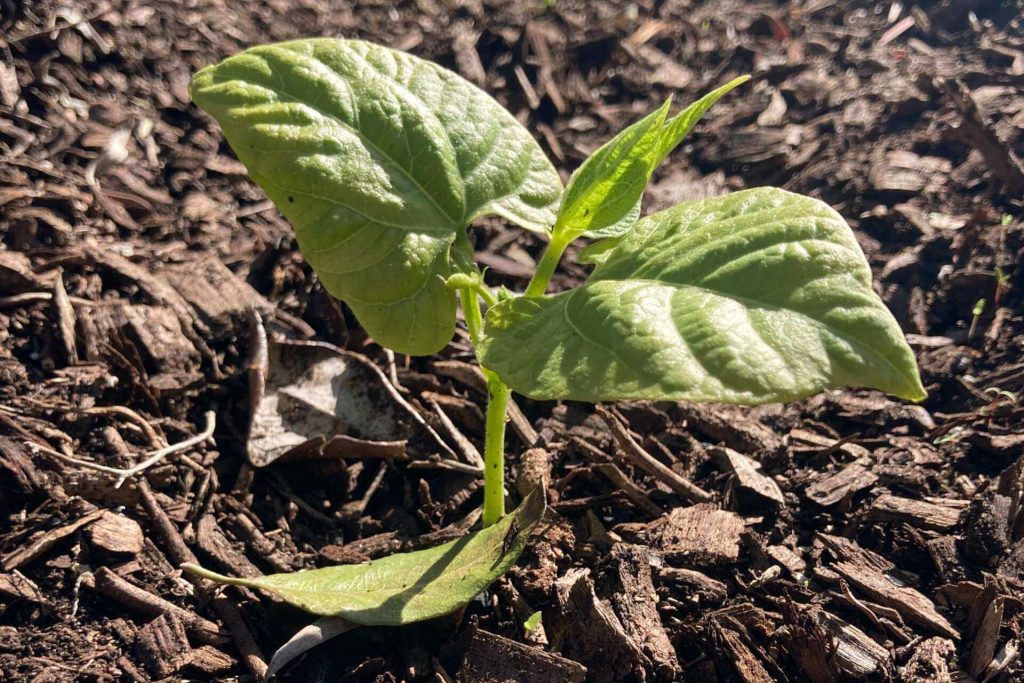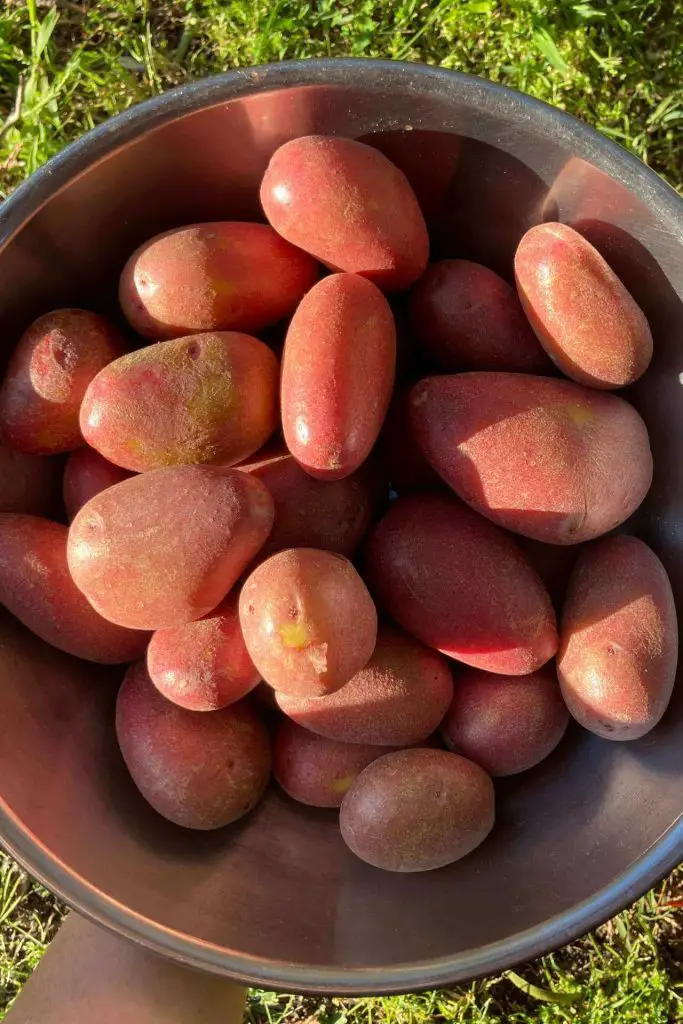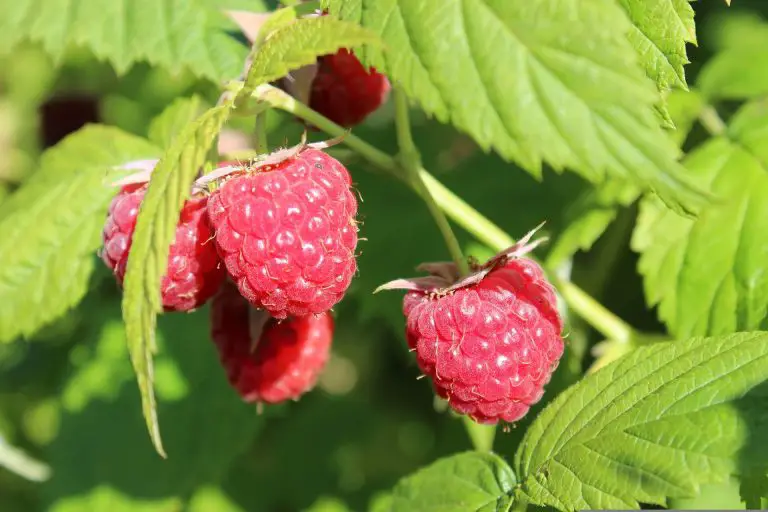35 Companion Plants For Chard: Your Complete Guide For 2023!
Are you looking for good companion plants for chard to plant in your garden?
Companion planting for Swiss chard is an enjoyable and rewarding activity and I can’t encourage you to try it out!
Chard is a nutrient-rich leafy green that is packed with vitamins, minerals, and antioxidants. When grown with companion plants, chard can benefit from its pest-repelling properties and its ability to improve soil health.
If you’re a long-time reader of this blog, then you’ll know already that I’m a bit of a foodie, but have I ever told you that I love to eat chard?
It all started when I lived in New Zealand. I was visiting a friend’s house and his mom cooked lunch of chard frittata for us. This was the first time I had ever tried chard (well, they call it silverbeet in New Zealand, but it’s the same thing), and I was hooked!
Lucky for me, chard grows well in New Zealand and it seems to be in abundance in everyone’s gardens, so there were plenty of friends willing to give me some when I wanted to try a new recipe.
So then I tried sauteed chard, kumara (sweet potato) with chard and mozzarella, chard and cheese pies, chard with bacon, rosemary, and pumpkin… I’m getting hungry just thinking about all the great chard recipes!
Anyway, enough about the food, you’re here to find out what companion plants you can plant next to chard, right? Read on to find out which plants are best, which ones are no-nos, and a couple of helpful tips on how to grow the best chard crop in your backyard!
Best Companion Plants For Chard
1. Shallots
2. Leeks
3. Chives
4. Cabbages
5. Brussel Sprouts
6. Turnips
7. Kohlrabi
8. Collard Greens
9. Peppermint
10. Cilantro
11. Bush Beans
12. Peas
13. Sweet Alyssum
14. Nasturtiums
15. Marigolds
16. Lettuce
17. Garlic
18. Onions
19. Broccoli
20. Kale
21. Radishes
22. Celery
23. Dill
24. Marjoram
25. Lovage
26. Lavender
27. Mint
28. Fava Beans
29. Garbanzo Beans
30. Rosemary
31. Thyme
32. Basil
33. Arugula
34. Bok Choy
35. Carrots

Affiliate Link Disclosure
Some of the links on here are affiliate links and I may earn if you click on them, AT NO EXTRA cost to you. I hope you find the information here useful! Thanks
Related Posts
- How To Harvest Swiss Chard Without Killing The Plant [Exact Steps!]
- Companion Plants For Leeks: 17 Plants That Will Boost Growth
- 27 Companion Plants For Mint To Thrive (And Avoid!)
- 17 Companion Plants For Pumpkins-Help Them THRIVE!
35 Chard Companion Plants
1. Shallots
- Benefits: Keeps away pests.
- Spacing Requirements: 6-8 inches apart
- Time From Seed To Harvest: 100-120 days
- Popular Varieties: Zebrune, Red, Holland Red
2. Leeks
- Benefits: Keeps away pests.
- Spacing Requirements: 6 inches apart in rows 12 inches apart
- Time From Seed To Harvest: 100-140 days
- Popular Varieties: American Flag, Giant Leek
3. Chives
- Benefits: Keeps away pests.
- Spacing Requirements: 6 inches apart
- Time From Seed To Harvest: Any time 60 days after sowing seed
- Popular Varieties: Garden Chives, Garlic Chives
4. Cabbages
- Benefits: Loosens the soil.
- Spacing Requirements: 15-20 inches apart
- Time From Seed To Harvest: 60-100 days
- Popular Varieties: Copenhagen Market, Late Flat Dutch, Golden Acre

5. Brussel Sprouts
- Benefits: Has a shallow root system, keeps away pests
- Spacing Requirements: 6 inches apart
- Time From Seed To Harvest: 80-100 days
- Popular Varieties: Long Island Improved, Catskill, Churchill
6. Turnips
- Benefits: Take up minimal space and repels pests
- Spacing Requirements: 1-2 inches apart in rows 18-30 inches apart
- Time From Seed To Harvest: 40-55 days
- Popular Varieties: Purple Top, Snowball, Seven Top
7. Kohlrabi
- Benefits: Loosens the soil.
- Spacing Requirements: 9-12 inches apart
- Time From Seed To Harvest: Approximately 55 days
- Popular Varieties: Purple Vienna, Early White Vienna
8. Collard Greens
- Benefits: Described as a trap plant – attracts bugs themselves, drawing them away from the chard
- Spacing Requirements: 12 inches apart
- Time From Seed To Harvest: 55-75 days
- Popular Varieties: Champion, Georgia Southern
9. Peppermint
- Benefits: If allowed to bloom, will attract beneficial insects with its masses of flowers. Mint also repels flea beetles, a common pest for chard
- Spacing Requirements: 18-24 inches apart
- Time From Seed To Harvest: Reaches full maturity at about 90 days, and 1-2 feet tall. At this point, you can cut it down to 1 inch above the soil and it will regrow to the pre-cut height in 6-8 weeks
- Popular Varieties: Menthe Piperita
10. Cilantro
- Benefits: Improves general soil health, attracts good insects, and repels bad ones
- Spacing Requirements: 2 inches apart in rows 15 inches apart
- Time From Seed To Harvest: Cilantro leaves can be harvested any time after the plant is 6-8 inches tall, however plants mature 60-75 days after sowing
- Popular Varieties: Coriandrum Sativum

11. Bush Beans
- Benefits: Will fix nitrogen in the soil.
- Spacing Requirements: 2 inches apart in rows 18 inches apart
- Time From Seed To Harvest: About 40-60 days after planting
- Popular Varieties: Blue Lake, Slenderette, Provider, Contender
12. Peas
- Benefits: Will fix nitrogen in the soil.
- Spacing Requirements: 2-3 inches apart in rows 18 inches apart
- Time From Seed To Harvest: Approximately 10-14 weeks after planting, depending on the variety.
- Popular Varieties: Sugar Snap, Green Arrow, Dwarf Sugar Grey, Purple Hull
13. Sweet Alyssum
- Benefits: Acts as a ground cover which reduces the number of weeds, and also stops soil erosion.
- Spacing Requirements: 3-4 inches apart
- Time From Seed To Harvest: These take about 9-10 weeks to flower from the time you planted the seeds.
- Popular Varieties: Royal Carpet, Carpet Of Snow, Oriental Nights
14. Nasturtiums
- Benefits: Good as a marker plant in between rows and also acts as a trap plant – attracting bugs themselves and drawing them away from the chard
- Spacing Requirements: 3 inches apart
- Time From Seed To Harvest: These flowers are some of the quickest growing plants, with flowers being produced around 6 weeks after planting, between 35-50 days after germination.
- Popular Varieties: Dwarf Jewel Mix, Jewel Mix, Black Velvet, Peach Melba, Cherry Rose
15. Marigolds
- Benefits: Repels nematodes.
- Spacing Requirements: 10-12 inches apart
- Time From Seed To Harvest: Depending on the variety, marigold plants will flower anywhere between 50-100 days after planting the seeds.
- Popular Varieties: Petite Mix, Crackerjack Mix, French
16. Lettuce
- Benefits: Has a shallow root system, so won’t compete for space with your chard. Also covers the soil, preventing weeds from popping up and slowing erosion.
- Spacing Requirements: 8-12 inches apart
- Time From Seed To Harvest: Depending on the variety, anywhere from 30-70 days from planting to harvesting
- Popular Varieties: Romaine, Buttercrunch, Little Gem, Red Romaine, Cos, Iceberg, Collection

17. Garlic
- Benefits: Will keep away pests.
- Spacing Requirements: 6 inches apart
- Time From Seed To Harvest: Garlic is a long maturing crop and takes 8-9 months to grow from plantable cloves to harvest. Timing is also very important with garlic, where we are, we only grow garlic planted in fall and harvested at the start of summer, however, lots of climates will support a spring-planting season as well.
- Popular Varieties: California, Siberian Hardneck, Elephant (a personal favorite of mine!) Chesnok Red, Dichondra Black
18. Onions
- Benefits: Can make chard taste better, will also keep away bugs, also handy markers and dividers as well
- Spacing Requirements: 2 inches apart for smaller bulbs, 4 inches apart for bigger bulbs
- Time From Seed To Harvest: Onions are a very long crop, taking 100-120 days to grow from seed to a full bulb
- Popular Varieties: Texas Grano, Walla Walla, Yellow Sweet Spanish, Red Creole, Gladstone White, Utah Yellow Sweet
19. Broccoli
- Benefits: Improves soil health, attracts good bugs, and repels bad ones
- Spacing Requirements: 18 inches apart
- Time From Seed To Harvest: 100-150 days from seed, however seedlings speed things up a lot and take 55-80 to harvest from the planting of the seedling.
- Popular Varieties: Waltham 29, Green Sprouting Calabrese, Sun King
20. Kale
- Benefits: Loosens the soil.
- Spacing Requirements: 18-24 inches apart
- Time From Seed To Harvest: 55-75 days
- Popular Varieties: Lacinato, Vates Blue Scotch Curled, Dwarf Siberian Curled, Russian Red
21. Radishes
- Benefits: Loosens the soil.
- Spacing Requirements: 2-3 inches apart
- Time From Seed To Harvest: 30-50 days
- Popular Varieties: Champion, Cherry Belle, Early Scarlet Globe, French Breakfast Radish, Watermelon Radish, Daikon

22. Celery
- Benefits: a compact plant that doesn’t get in chard’s way, has a shallow root system, keeps away pests
- Spacing Requirements: 1 inch apart
- Time From Seed To Harvest: 100 days
- Popular Varieties: Tall Utah, Tendercrisp, Tango
23. Dill
- Benefits: Attracts pollinators that help chard grow
- Spacing Requirements: 10-12 inches apart
- Time From Seed To Harvest: 90 days
- Popular Varieties: Mammoth Long Island, Bouquet, Fernleaf
24. Marjoram
- Benefits: Will keep away pests.
- Spacing Requirements: 12 inches apart
- Time From Seed To Harvest: 40 days, when the flowers are just about to open and the plant is about 3 feet tall
- Popular Varieties: Sweet Marjoram
25. Lovage
- Benefits: Improves the health of chard, especially good at attracting beneficial insects including bees, wasps, and beetles
- Spacing Requirements: 24 inches apart
- Time From Seed To Harvest: 85-95 days
- Popular Varieties: Common Lovage
26. Lavender
- Benefits: Improves the flavor of your chard.
- Spacing Requirements: If growing in groups, space plants 3 foot apart, if growing as a hedge, grow 1 foot apart
- Time From Seed To Harvest: It normally takes about 3 years for lavender to reach maturity, and, while you can pick flowers in the first year or two, if you leave the plants alone they will grow and develop better.
- Popular Varieties: English, Spike, French Provence, Vera, Hidcote Blue, Munstead
27. Mint
- Benefits: If allowed to bloom, will attract beneficial insects with its masses of flowers. Mint also repels flea beetles, a common pest for chard.
- Spacing Requirements: Space mint 18-24 inches apart, but its best to grow mint in pots so it doesn’t take over your garden
- Time From Seed To Harvest: 90 days
- Popular Varieties: Spearmint, Peppermint, Lemon Mint, Catmint
28. Fava Beans
- Benefits: Will fix nitrogen in the soil.
- Spacing Requirements: Plant seeds about 6 inches apart, and rows 2-3 feet apart
- Time From Seed To Harvest: 80-100 days
- Popular Varieties: Broad Windsor
29. Garbanzo Beans
- Benefits: It fixes nitrogen in the soil
- Spacing Requirements: Plant 3-5 inches apart and 8-10 inches between rows
- Time From Seed To Harvest: 100 days
- Popular Varieties: Garbanzo Beans
30. Rosemary
- Benefits: Will improve the flavor of your chard.
- Spacing Requirements: Space plants 2-3 feet apart if you just want bushes, I have had success planting cuttings about 4 inches apart to create a thick hedge
- Time From Seed To Harvest: 40 days
- Popular Varieties: Rosemary Seeds
31. Thyme
- Benefits: Will improve the flavor of your chard.
- Spacing Requirements: 12-24 inches apart, depending on the variety
- Time From Seed To Harvest: Thyme grows very slowly, and germination from seed alone can take at least 28 days. You can begin to harvest thyme when they start to reach a height of 6-8 inches, which will take at least 70 days after planting.
- Popular Varieties: Thyme Seeds
32. Basil
- Benefits: Attracts good insects and repels aphids.
- Spacing Requirements: 12-16 inches apart
- Time From Seed To Harvest: 21-28 days
33. Arugula
- Benefits: Helps deter pests such as flea beetles, and will attract beneficial insects and pollinators
- Spacing Requirements: 12-18 inches apart
- Time From Seed To Harvest: 40-60 days
34. Bok Choy
- Benefits: Repels pests and attracts beneficial insects
- Spacing Requirements: 10 inches apart
- Time From Seed To Harvest: 50-70 days, however, you can harvest them when they are smaller, at about 30-35 days if you want a smaller head with more tender leaves
- Popular Varieties: White Stem, Pak Choi, Baby Bok Choy, Purple Lady
35. Carrots
- Benefits: Repels pests and attracts beneficial insects
- Spacing Requirements: Plant carrot seeds ¼ inch deep and 1 inch apart, then, thin to 2-3 inches apart in rows 16-24 inches apart
- Time From Seed To Harvest: Carrots are ready 70 days after sowing, however, you can leave them to grow in the ground for a further b days after this before they must be harvested
- Popular Varieties: Imperator 58, Rainbow, Tendersweet, Scarlet Nantes, Danvers Half Long, Little Fingers

13 Plants To Avoid Planting Near Chard
1. Beets
Why? Attracts the same pests and diseases, so best to grow away from chard so that you can slow down pests from eating your entire garden and slow the spread of disease.
2. Spinach
Why? Attracts the same pests and diseases.
3. Amaranth
Why? Attracts the same pests and diseases.
4. Quinoa
Why? Attracts the same pests and diseases.
5. Cucumber
Why? A heavy feeder, competing for nitrogen in the soil, and the vines could easily overwhelm and strangle your chard crop.
6. Melons
Why? A heavy feeder, competing for nitrogen in the soil, and the vines could easily overwhelm and strangle your chard crop.
7. Squash
Why? A heavy feeder, competing for nitrogen in the soil, and the vines could easily overwhelm and strangle your chard crop.
8. Pole Beans
Why? Pole beans can get really big when you trellis them, and they also start to take off in late spring or early summer, which means they may shade out your chard crop.
9. Sunflowers
Why? Sunflowers are allelopathic, which means they exude chemicals from their roots, leaves, and stems which are harmful to other plants.
10. Corn
Why? Corn is a heavy feeder, and will compete for nitrogen in the soil, leaving none left for your chard.

11. Potatoes
Why? Potatoes are heavy feeders and will compete for nitrogen in the soil, leaving none left for your chard.
12. Gourds
Why? A heavy feeder, competing for nitrogen in the soil, and the vines could easily overwhelm and strangle your chard crop.
13. Pumpkins
Why? A heavy feeder, competing for nitrogen in the soil, and the vines could easily overwhelm and strangle your chard crop.

FAQs On Companion Plants For Chard
What Is Companion Planting?
So what is companion planting? Companion planting is planting plants next to other plants that will benefit them in some way, either by making them taste better, improving the soil, loosening the soil, repelling pests, and attracting good insects.
Why Should I Do Companion Planting?
Why should I do companion planting? Companion planting is a method of growing plants together so that they mutually assist each other.
Companion planting has been shown to improve the flavor of the plants, improve growth, fix the nitrogen in the soil, loosen the soil, attract beneficial insects and repel pests.
If you are going to grow the plants anyway, why not put a tiny bit more effort into planning what you plant next to each other to maximize their output?
What Are Some Chard Planting And Growing Tips?
Curious about what are some chard planting and growing tips? If you would like to know how to consistently grow chard in your garden, here are my tops tips;
- They love a sunny position with well-draining soil, that’s both moist and fertile
- The more you pick them the more they’ll grow, so make sure you harvest them regularly!
- They will last several years in your garden, so make sure you plant them somewhere you don’t mind having them for a long time.
- They should be planted 18-30 inches apart and will be ready to harvest in 50-60 days.
- When we need some in my kitchen, we just cut off the outside leaves at the base until we have enough, give them a quick rinse and they’re ready to be used!
Chard is consistently one of the best-performing crops in my garden, and these tips will be sure to help you have the same!
What Are The Best Varieties Of Chard To Grow?
What are the best varieties of chard to grow? I have personally grown Fordhook Giant and Rainbow, and these are my go-to Chard varieties. Still, you could also try Barese, Large White Ribbed, Lucullus, Magenta Sunset, Orange Fantasia, or Peppermint if you want to try something different!
What Should Not Be Planted Next To Swiss Chard?
What should not be planted next to swiss chard? Several plants should not be planted next to Chard for various reasons. These are;
1. Beets
2. Spinach
3. Amaranth
4. Quinoa
5. Cucumber
6. Melons
7. Squash
8. Pole Beans
9. Sunflowers
10. Corn
11. Potatoes
12. Gourds
13. Pumpkins

What Grows Well With Chard?
What grows well with chard?
Many plants make suitable Swiss Chard companion plants, but the best are;
1. Shallots
2. Leeks
3. Chives
4. Cabbages
5. Brussel Sprouts
6. Turnips
7. Kohlrabi
8. Collard Greens
9. Peppermint
10. Cilantro
11. Bush Beans
12. Peas
13. Sweet Alyssum
14. Nasturtiums
15. Marigolds
16. Lettuce
17. Garlic
18. Onions
19. Broccoli
20. Kale
21. Radishes
22. Celery
23. Dill
24. Marjoram
25. Lovage
26. Lavender
27. Mint
28. Fava Beans
29. Garbanzo Beans
30. Rosemary
31. Thyme
32. Basil
33. Arugula
34. Bok Choy
35. Carrots

Can You Plant Strawberries And Swiss Chard Together?
If you are wondering if Strawberries can be a companion for Swiss chard, the answer is yes, you can plant Strawberries next to Swiss Chard, and you may even find they improve the flavor of the Chard!
Can I Plant Kale And Swiss Chard Together?
If you are wondering what to plant with Swiss Chard, you’ll be pleased to know that kale is a great companion plant, as it loosens the soil, improving the soil conditions for the Swiss Chard.
What Not To Plant Next To Swiss Chard
What not to plant next to swiss chard? Several plants should never be considered as companion plants for Swiss chard for various reasons. These are;
1. Beets
2. Spinach
3. Amaranth
4. Quinoa
5. Cucumber
6. Melons
7. Squash
8. Pole Beans
9. Sunflowers
10. Corn
11. Potatoes
12. Gourds
13. Pumpkins
Can You Plant Swiss Chard With Tomatoes
Can you plant swiss chard with tomatoes? Swiss Chard and Tomatoes are great to plant together as they make really good use of space in a small garden.
They both love a lot of sun, so make sure you plant them somewhere with at least six hours of sunlight a day. They also both love a similar amount of water (about 2 inches a week), and a 3-inch layer of mulch (high in nitrogen if possible) around them to stop the soil from drying out.
I also recommend leaving at least 24 inches between the tomatoes and Swiss Chard and training the Tomato plants to grow on stakes on in a tomato cage, to not crowd out the Swiss Chard too much.

What To Plant After Swiss Chard
If you are wondering what to plant after Swiss Chard, you can try any of the plants from my list above, including, Cabbage, Broccoli, Shallots, Leeks, Chives, Cabbages, Brussel Sprouts, and Turnips, just to name a few.
There are many reasons to grow companion plants for chard. Chard is such a good addition to any diet, and it’s really easy to grow. There is nothing better than being able to walk out to your garden and pick some chard for that chard frittata you’re now inspired to cook!
Companion planting for chard can also help protect chard from pests and diseases, plus help to keep the soil moist and improve drainage.
I would love to see you grow companion plants for chard alongside your crop of chard and see why I’m so hyped about the benefits! Growing Swiss chard with companion plants is a great way to get the most out of this nutrient-rich leafy green, and get it on your plate sooner!
Related Posts
- 23 Companion Plants For Sage & What To Avoid! [2023]
- 13 Companion Plants For Turnips: Best and Worst! [2023]
- 27 Companion Plants For Basil, The Best and Worst! [2023]
- 25 Companion Plants For Rhubarb, Which to Avoid & Growing Tips!
- 15 Companion Plants For Asparagus To Help It THRIVE! [2023]

![How To Preserve Willow Branches [2022 Guide]](https://aboveandbeyondgardening.com/wp-content/uploads/2021/10/how-to-preserve-willow-branches-768x512.jpg)
![8 Pumpkin Growing Stages [+ Growth Tips!]](https://aboveandbeyondgardening.com/wp-content/uploads/2022/10/Pumpkin-Growing-Stages-9-768x512.jpg)

![How To Get Rid Of Pot Worms [A Quick And Easy Guide 2022]](https://aboveandbeyondgardening.com/wp-content/uploads/2021/10/How-To-Get-Rid-Of-Pot-Worms-768x600.jpg)

![When To Pick Carrots [+ Harvesting Tips!]](https://aboveandbeyondgardening.com/wp-content/uploads/2021/10/When-To-Pick-Carrots-768x512.jpg)